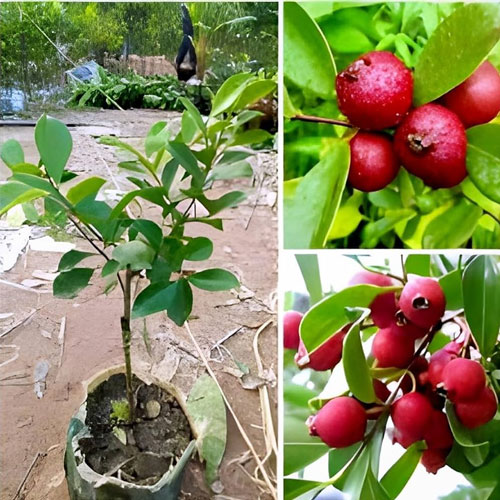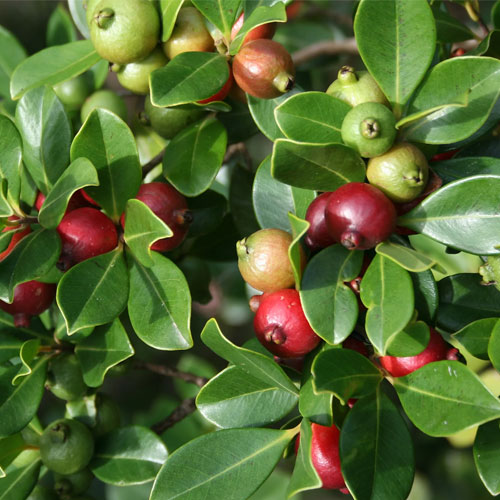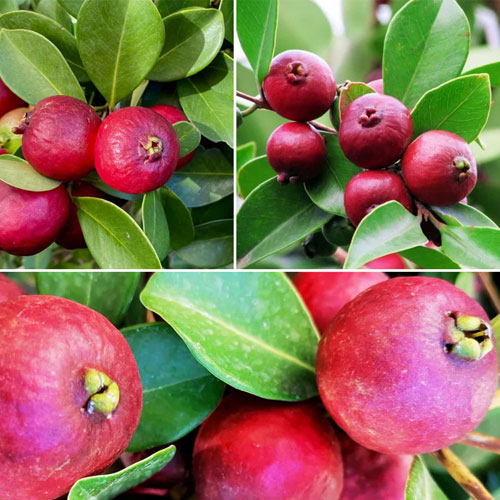Experience the joy of growing exotic fruits right at home with the Strawberry Guava Red Guava Live Plant (Psidium cattleianum) – a rare and beautiful tropical fruiting shrub with shiny leaves, delicate white flowers, and sweet, aromatic red guava fruits. Unlike regular guavas, this variety is compact, fast-growing, and ideal for pots and small gardens, offering both ornamental beauty and delicious harvests.
Perfect for home gardens, edible landscapes, terrace pots, and kitchen gardens, the strawberry guava is admired for its strawberry-like aroma, small crimson-red fruits, and ease of cultivation. With proper care, this plant can fruit within 1–2 years in Indian climates.
Type of Plant: Live Fruit Plant (Psidium cattleianum)
Germination Time: Not applicable (live plant)
Hours of Sunlight Needed: 5–6 hours of full sunlight
Where to Grow: Pots, terrace gardens, outdoor soil beds
Growing Season: Year-round planting possible; fruits in late summer & winter
Seed Sowing Depth: Not applicable
Ideal Climate: Tropical and subtropical
Plant Height: Grows 6–12 feet (can be pruned); delivered plant 1.5–2 feet
Organic Fertilizer Requirements: Monthly compost + cow dung mix
Life Span: Perennial
Ideal Growing Temperature: 20°C to 35°C
Harvesting Time: 10–14 months after planting; fruits twice a year
Maintenance Required: Low
Watering Frequency: Twice a week or when topsoil feels dry
Ideal Grow Bag Size: 15x15 inch or large grow bags/pots



The Strawberry Guava plant thrives throughout the year in most Indian regions. In tropical states like Kerala, Tamil Nadu, and Maharashtra, it performs excellently when planted any time. It fruits mainly in late summer (May–June) and again in winter (November–January), depending on weather and care.
Use a 15-inch pot or grow bag with drainage. Mix red soil, cocopeat, and compost for ideal results. Place the plant in an area receiving at least 5–6 hours of sunlight daily. Water moderately and fertilize monthly with organic compost. Prune yearly to maintain shape and boost branching.
Not applicable – this is a live plant, not seed.
Sunlight: Full sun is best; minimum 5–6 hrs/day.
Soil: Rich, well-draining, slightly acidic to neutral.
Fertilization: Organic compost monthly; add potash during flowering.
Pruning: Trim lightly after fruiting to control size and improve shape.
Support & Spacing: No support needed. Leave 2–3 feet around if planted in ground.
Pest Control: Rarely affected; use neem oil if aphids appear.
Disease Prevention: Avoid waterlogging to prevent root rot.
Mulching: Add mulch to retain moisture.
Harvesting: Pick fruits when deep red and fragrant.
1. Apply Nutrient-Rich Fertilizers
When your plants begin flowering, use nutrient-rich fertilizers like Organic Bone Meal Powder or Vermicompost. This helps in boosting the bloom and enhances overall yield.
2. Use Organic Fertilizers
Feed your plants with organic fertilizers such as Cow Dung Manure or Neem Cake. Organic options promote healthy soil life.
3. Regular Feeding
Apply fertilizers every 20-25 days to ensure plants receive a steady supply of nutrients. Choose from various options like Cocopeat Compost for moisture retention.
The Strawberry Guava is a compact guava tree known for its aromatic red fruits, which have a unique taste combining the tartness of guava and the sweet fragrance of strawberries. This plant is ornamental as well as fruit-bearing, and its glossy evergreen foliage looks beautiful throughout the year. The white, powder-puff flowers are also attractive to pollinators like bees.
Ideal for balconies, small gardens, containers, and even bonsai, this variety is low-maintenance and very productive under the right care.
Produces small, red, vitamin C-rich guava fruits
Used in jams, jellies, juices, and desserts
Beautiful evergreen foliage and white flowers
Ideal for urban edible gardens and compact spaces
Great gifting plant for fruit lovers
Avoid planting in poorly drained clay soils. Young plants need protection from strong winds. Use only organic fertilizers – chemical fertilizers may cause leaf burn. Overwatering can lead to root rot. In pots, ensure proper drainage holes and do not let water stand in the tray below.
Yellow Leaves: Caused by overwatering or poor drainage – fix soil mix and reduce watering.
No Fruits: Due to insufficient sunlight or fertilization – move to a sunnier spot and add potash-rich organic fertilizer.
Leaf Curling: Usually due to pests or undernourishment – spray neem oil and apply compost.
Falling Flowers: Natural in young plants or due to inconsistent watering – maintain regular moisture.
Sweet Red Guava, Strawberry Guava, Cherry Guava, Red Guava Plant, Psidium cattleianum, Peru Chethi, Seemai Koyya, Guava Cherry Plant, Myrtaceae Family Fruit Plant
Q1. Is this a seedling or grafted plant?
This is a seedling live plant, grown from high-quality mother plants for best fruiting.
Q2. Can it be grown in pots permanently?
Yes, it grows well in pots (15–20 inch) and produces fruits even in containers.
Q3. When will it start fruiting?
Usually within 10–14 months with proper sunlight and organic feeding.
Q4. How big will it grow?
In the ground, it can reach 10–12 feet. In pots, it stays around 4–6 feet when pruned.
Q5. Is it different from regular guava?
Yes. It produces smaller, sweeter fruits with a strawberry aroma and has a bushier growth habit.
Sign in now to receive a 5% instant discount on your first order when using code WELCOME. Begin your organic journey today!
By logging in, you're agreeing to our Terms of Service and Privacy Policy.
Priya Singh
Plant strong aur alive tha. Moist soil aur packaging perfect thi. Recommended.
Suresh Reddy
Plant fruiting stage ke liye ready lagta hai. Packaging aur quality dono excellent.
Ritika Jain
Plant green aur healthy. Roots well packed the aur delivery fast thi.
Manoj Pillai
Bahut rare aur beautiful plant. Golden Hills Farm se trusted purchase. 🌿
Kavita Menon
Delivery safe thi aur packaging neat. Leaves aur stem dono fresh the.
Vikram Rao
Roots strong aur stem thick hai. Fruiting plant ke liye perfect choice.
Anjali Joshi
Healthy aur fresh plant. Pot me transplant karte hi grow kar gaya. Bahut accha experience.
Deepak Patil
Plant thoda late deliver hua par condition excellent thi. Fruits ka wait hai. 🍒
Sneha Nair
Bahut khubsurat plant mila. Soil wet thi aur roots healthy. Growth fast ho raha hai. 🌱
Arjun Singh
Plant healthy hai par thoda chhota tha. Still satisfied, good variety.